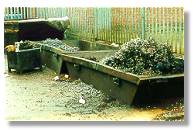| Unit 4: Current Legislation Affecting UK Industry: Land |
|
4.4 Contaminated Land Contaminated land is a complex area of study. The estimation for the UK is that over 27 000 hectares of land are contaminated from past or present industrial and commercial processes from landfills, to accidental spillages, to smelting. The hazards arising from contaminated land are various. |
|
The UK legislation dealing with the identification and remediation of contaminated land has been thoroughly revised since the passing of the Environment Act 1995. Prior to this, contaminated land had mainly been covered by in planning law and the planning process such as the Town and Country Planning Act 1990 or the Building Regulations 1991, and also in s.143 of EPA 1990. This makes a requirement for a register of contaminated land to be maintained by each district council or London borough. This was however, peppered with ambiguities and unanswered questions such as who would pay for the cost of clean up. EA 1995, however, introduced a new contaminated land regulation regime inserting into EPA 1990 a new part- IIA. There is a timetable for passing the new regime as law in place. The government has re-drafted the guidance associated with this regime and proposes to pass it as law in July 1995. |

|
|
|
The legislative framework mentioned above and a summary of the current legislation, which relates to contaminated land, will be looked at here. The current legislation will be focused upon in terms of the following areas: regulation: planning, public health and safety, pollution control and protection of the environment, and the new measures introduced by EA 1995. What should be emphasised here is the overall objective of the regulation, which is reflected by the relevant governmental consultation papers is to restore the land to a state suitable for its intended use. |